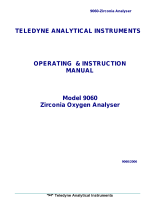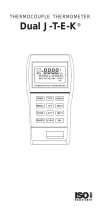Page is loading ...

TELEDYNEANALYTICAL
INSTRUMENTS
OxygenTransmitter
Model9060Z
TechnicalManual

Model9060ZManual
2
TABLEOFCONTENTS
TABLEOFCONTENTS........................................................................................................... 1
1.IMPORTANTNOTICES......................................................................................................7
2.INTRODUCTION..............................................................................................................8
2.19060ZTRANSMITTER.................................................................................................8
2.2SERIES9060HOXYGENPROBES&SENSORS..................................................................8
2.3WARNINGSYMBOLS......................................................................................................9
3.DEVICESPECIFICATIONS..................................................................................................10
3.1HARDWARESPECIFICATIONS.........................................................................................10
3.1.1TransmitterSpecifications......................................................................................1
0
3.1.2Standard‘U’Lengths..............................................................................................10
3.1.3Series9060HProbesSpecifications......................................................................11
3.1.4OxygenProbeModelSelectionGuide...................................................................12
3.2OPERATIONALSPECIFICATIONS...................................................................................14
4.INSTALLATIONANDCOMMISSIONING...........................................................................15
4.1MOUNTINGTHETRANSMITTER....................................................................................15
4.2INSTALLINGA9060HOXYGENPROBE...........................................................................15
4.3INSTALLINGTHEAUXILIARYTHERMOCOUPLE..............................................................17
4.4ASHIELDCONNECTIONS..............................................................................................17
4.4BEARTHCONNECTION(PE)...........................................................................................17
4.5ELECTRICALCONNECTIONS..........................................................................................17
4.6HEATERINTERLOCKRELAYS..........................................................................................20
4.7CONNECTINGANOX
YGENPROBECABLE......................................................................20
4.8CONNECTINGTHEAUXILIARYTHERMOCOUPLE(OPTIONAL)........................................22
4.9CONNECTINGTHEOUTP
UTCHANNELS........................................................................22
4.10CONNECTINGTHEALARMS........................................................................................22
4.11CONNECTINGTHEAUTOMATICPURGEANDCALIBRATIONCHECKSYSTEM...............22
4.12CONNECTINGREFERENCEAIR.....................................................................................23
4.13CONNECTINGTHETRANSMITTERTOAMODBUS™NETWORK....................................23
4.14CONNECTINGPOWER.................................................................................................24
4.15COMMISSIONING‐RUNMODE..................................................................................24
4.16PROBEORSEN
SORCALIBRATION..............................................................................24
4.17FILTERPURGING........................................................................................................25
4.18CALIBRATIONGASCHECK..........................................................................................25
4.19DUSTINTHEFLUEGAS....................................................... ......................................25
4.20STRATIFICATION........................................................................................................26
4.21CONNECTINGAPRESSURETRANSDUCER....................................................................26
5.DISPLAYANDKEYPAD...................................................................................................27
5.1GRAPHICALDISPLAY..................................................................................................... 27
5.2OXYGENDISPLAYUNITS...............................................................................................28

Model9060ZManual
3
5.3KEYPAD........................................................................................................................28
5.3.1KeypadinRUNmode..........................................................................................29
5.3.2KeypadinSETUP/COMMISSIONING/CALIBRATIONmodes...............................29
6.SETUPMODE.................................................................................................................31
6.1FUNCTIONSUMMARYTABLE.......................................................................................31
6.2CHANGINGOPTIONS...................................................................................................31
6.3SETUPMODEFUNCTIONS.............................................................................................32
6.3.1Probe1Offset................ ..................................................................... .................32
6.3.2LowerLineItems.................................................................................................32
6.3.3OxygenDisplayUnits...........................................................................................33
6.3.4DampingFactor...................................................................................................33
6.3.5ProcessAlarms....................................................................................................33
7.COMMISSIONINGMODE................................................................................................34
7.1FUNCTIONSUMMARYTABLE........................................................................................34
7.2COMMISSIONINGMODEFUNCTIONS..........................................................................36
7.2.1InternalDate/Time............................................................................................36
7.2.2ServiceDate........................................................................................................36
7.2.3NumberofProbes...............................................................................................36
7.2.4Probe1&2Type.................................................................................................36
7.2.5Probe1&2ThermocoupleType..........................................................................36
7.2.6AuxiliaryThermocoupleType..............................................................................36
7.2.7TransmitterOutputChannel1&2.......................................................................36
7.2.8FluePressureUnitsandValue.............................................................................38
7.2.9TemperatureUnits...............................................................................................38
7.2.10CalibrationFreezesOutputs..............................................................................38
7.2.11Solenoid1&2Operation................................................... ................................38
7.2.12Solenoid1&2Automatic/Manual...................................................................38
7.2.13Solenoid1&2StartTime...................................................................................38
7.2.14Solenoid1&2Period........................................................................................38
7.2.15Solenoid1&2Duration.................................................................................... 38
7.2.16Solenoid1&2PostFreeze.................................................................................39
7.2.17OxygenContentCalibrationGas1&2...............................................................39
7.2.18MaximumCalibrationGas1&2Positive/NegativeError.................................39
7.2.19ProcessAlarms..................................................................................................39
7.2.20AlarmRelay1,2and3Function........................................................................39
7.2.21Com
monAlarmRelayFunction..........................................................................39
7.2.22OperationoftheAlarmRelayswhenanAlarmisAccepted................................40
7.2.23SelectingtheCorrectFuel..................................................................................40
7.2.24ReferenceAirPu
mpOptions................................................ ..............................40
7.2.25CommunicationsPortOptions...........................................................................41
7.2.26AlarmLogClearing............................................................................................41
8.CALIBRATIONMODE.....................................................................................................42

Model9060ZManual
4
8.1FUNCTIONSUMMARYTABLE......................................................................................42
8.2CALIBRATIONMODEFUNCTIONS................................................................................43
8.2.1ReferenceVoltages.............................................................................................43
8.2.2OutputChannel1and2Calibration....................................................................43
8.2.3AmbientTemperatureCalibration.......................................................................43
8.2.4LowOxygenCalibration......................................................................................43
8.2.5TransmitterOutputScale....................................................................................43
8.2.6TransmitterOutputLimiting................................................................................43
8.2.7MainsVoltageDetection.....................................................................................43
8.2.8HeaterSSRFaultCorrection.................................................................................44
8.2.9SSRFailProtection..............................................................................................44
9.ALARMS........................................................................................................................45
9.1COMMONALARMS................................ ......................................................................45
9.2SELECTABLEPROCESSALARMS....................................................................................47
9.3ALARMRELAYOPTIONS.................................................................. ............................48
10.INSTRUMENTCALI
BRATION........................................................................................49
10.1CALIBRATIONSUMMARY.....................................................................................49
10.1.1CalibrationoftheInputs....................................................................................49
10.1.2CalibrationoftheOutputs.................................................................................49
10.1.3ProbeCalibration..............................................................................................50
10.2COLDSTART..............................................................................................................50
10.2.1ForcingaColdStart...........................................................................................50
10.2.2ResettingtheCalibrationFactors.......................................................................50
11.GASCALIBRATIONCH
ECKANDPURGE.........................................................................51
11.1PURGE.......................................................................................................................51
11.2CALIBRATIONGAS.....................................................................................................51
12.SOFTWAREUPGRADES...............................................................................................52
13.TROUBLESHOOTING...................................................................................................53
13.1FIRSTAPPROACH........................................................................... ...........................53
13.2DETAILEDFAULTAN
ALYSIS.......................................................................................53
14.MAINTENANCE...........................................................................................................54
14.1TRANSMITTERMAINTENANCE..................................................................................54
14.2CLEANING.................................................................................................................. 54
14.3REPLACEMENTPARTS................................................................................................54
15.INDEX....................................................... ..................................................................55
APPENDIX1,CONSTITUENTVALUESFORVARIOUSF.LS...................................................57
APPENDIX2,PROBEEMFTABLES.....................................................................................58
APPENDIX3,%OXYGENSCALETOLOGARITHMIC............................................................60
APPENDIX4,MODBUS™....................................................................................................61

Model9060ZManual
5
CopyrightTELEDYNEANALYTICALINSTRUMENTS—2012
Thismanualdescribesthetransmitterfirmwareversion1.24,September2012
Neitherthewholenoranypartoftheinformationcontainedin,ortheproductdescribedin,this
manualmaybeadaptedorreproducedinanymaterialformexceptwiththepriorwrittenapprovalof
TeledyneAnalyticalInstruments.
The product described in this manual and products for use with it are subject to continuous
developmentsandimprovement.Allinformationofatechnicalnatureandparticularsoftheproduct
anditsuse(includingtheinformationinthismanual)aregivenbyTeledyneAnalyticalInstrumentsin
goodfaith.However,itisacknowledgedthattheremaybeerrorsoromissionsinthismanual.Alistof
detailsof anyamendmentsorrevisionsto thismanual canbeobtaineduponrequest fromTeledyne
AnalyticalInstruments.TeledyneAnalyticalInstrumentswelcomecommentsandsuggestionsrelating
totheproductandthismanual.
Allcorrespondenceshouldbeaddressedto:‐
TeledyneAnalyticalInstruments
16830ChestnutStreet
CityofIndustry,CA91748
Phone(626)934‐1500or(888)789‐8168
Fax(626)934‐1651
www.teledyne‐ai.com
Teledyne Analytical Instruments or their authorised dealers should carry out all maintenance and
serviceontheproduct.TeledyneAnalyticalInstrumentscanacceptnoliabilitywhatsoeverforanyloss
ordamagecausedbyserviceormaintenancebyunauthorisedpersonnel.Thismanualisintendedonly
toassistthereaderintheuseoftheproduct,an
dthereforeTeledyneAnalyticalInstrumentsshallnot
beliableforanylossordamagewhatsoeverarisingfromtheuseofanyinformationorparticularsin,
oranyerrororomissionin,thismanual,oranyincorrectuseoftheproduct.

Model9060ZManual
6
ImportantNoticeRegarding9060 ProbeOption‐FIL‐3
WARNING:TheonlyidentifiablestandardforflamearrestersforgeneraluseisBritishStandardBS
EN12874:2001.BritishStandardBSEN12874:2001referstoanoperatingenvironmentupto150
DegreesCentigrade.
The FIL‐3 device optionally fitted to 9060 Heated Zirconia Probes (the “Probes" or "Probe")
operateinanenvironmentconsiderablygreaterthan150DegreesCentigrade.
Therefore, we know of no Australian, British, European or USA standard applicable to flame
arrestersortheirtestingabove150degreesCentigrade.Consequently,theFIL‐3devicecannotbe
certifiedasasafetydevice.
Theprobeisonlyonprobesduringthestartupprocessesofacombustionappliance.
TheTeledyneAnalyticalInstrumentsBurnerInterlockRelayfacility,whichisastandardpartofthe
Teledyne Analytical Instruments transmitter, is designed to be wired to the main safety shut‐off
fuelvalvesinawaythatcanshutdowntheprobeheaterwhenthefuelvalvesareclosed.
TheriskofignitionofflammablegasmixtureatthehotendoftheProbecanonlybeminimizedby
correct use, maintenance and operation of the FIL‐3 device. The user of the FIL‐3 device is
responsibleforverificationandmaintenanceandcorrectuseandoperationoftheFIL‐3device.
THE USER AGREESTHAT IT USES THE PROBE AND THE FIL‐3 DEVICE AT ITS SOLE RISK. TELEDYNE
ANALYTICALINSTRUMENTSTOTHEFULLEXTENTPERMITTEDBYLAW,GIVESNOWARRANTIESOR
ASSURANCESANDEXCLUDESALLLIABILITY(INCLUDINGLIABILITYFORNEGLIGENCE)INRELATION
TOTHEPROBEANDTHEFIL‐3DE
VICE.
The user must ensure that it correctly follows all instructions in relation to the Probe and FIL‐3
device,correctlyunderstandsthespecificationsoftheProbeandFIL‐3deviceandensuresthatthe
ProbeandFIL‐3deviceareregularlyinspectedandmaintained.
FIL‐3equippedProbessho
uldbeinspectedatleastonceayearforcorrosionandmorefrequently
ifthereisanyreasontosuspectthatcorrosionmayhaveoccurred.

Model9060ZManual
7
1. IMPORTANTNOTICES
Thismanualisintendedasasupplementtothe9060ZOperatorsManual.Itisintendedtobeusedby
technicalpersonalthatarequalifiedtoinstall,commission,serviceandcalibrateelectronicindustrial
controlequipment.
Pleasereadthesafetyinformationbelowbeforeconnectingpowertothetransmitter.
CAUTION1
The probe heater is supplied with mains voltage. This supply has electrical shock danger to
maintenance personnel. Always isolate the transmitter before working with the probe. The EARTH
wires(green/yellow)fromaheatedprobemustALWAYSbeconnectedtoearth.
CAUTION2
Combustion oratmospherecontrol systemscanbedangerous. Burnersmustbe mechanicallysetup
so that in the case of equipment failure the system cannot generate explosive atmospheres. This
dangerisnormallyavoidedwithfluegastrimsystemsbyadjustmentsothatinthecaseoffailurethe
appliance will not generate CO in excess of 400 ppm in the flue. The CO level in the flue should be
measuredwithaseparateCOinstrumentnormallyaninfraredorfuelcelltype.
CAUTION3
Theoxygenprobeisheatedtoover700°C(1300°F)andisasourceofignition.Sincerawfuelleakscan
occurduringburnershutdown,thetransmitterhasaninterlockingrelaythatremovespowerfromthe
probeheaterwhenthemainfuelshut‐offvalvepowerisoff.Ifthisconfigurationdoesnotsuitorifit
is possible for raw fuel to come into contact with a hot oxygen probe then the Model 9060Z
transmitter with a heated probe will not be safe in your application. An unheated probe can be
utilizedinsuchapplications,howevertheoxygenreadingsarevalidonlyabove650°C(1200°F).
CAUTION4
Thereducing oxygen signalfrom the transmitterand the associatedalarm relaycanbe usedas an
explosive warning or trip. This measurement assumes complete combustion. If incomplete
combustionispossiblethenthissignalwillreadlessreducingandshouldnotbeusedasanalarmor
trip.Atrueexcesscombustiblesanalyzer,normallyincorporatingacatalystorthermalconductivity
bridge,would be more appropriatewhereincomplete combustion is possible.Alsoreadthe probe
electricalshockcautionintheprobeheaterinterlockcautioninchapter4.7
CAUTION5
FIL‐3filter.IftheoptionalFIL‐3hasbeenfittedtothe9060Hprobeinthisinstallation,pleasereadthe
ImportantNoticeregardingprobeoptionFIL‐3onthepreviouspage.
CAUTION6
CAUTION7
The heater is supplied from the mains power directly, and the temperature is controlled at 720°C
(1330°F). The outside of the process end of the probe can get to temperatures that are dangerous to
touch.Wearinsulatinggloveswhenhandlingaprobethathasbeenon.

Model9060ZManual
8
2.INTRODUCTION
2.19060ZTRANSMITTER
TheTeledyneAnalyticalInstruments9060Zoxygentransmitterisdesignedtomeasuretheoxygengas
concentration in combustion applications such as power stations and industrial boilers. The
measurement is used to control the air / fuel ration in the burner to maintain efficiency and safe
operationconditions.
The transmitter is designed to be used in conjunction with a Teledyne Analytical Instruments probe
model 9060H or 9060UL/UH. These two probes use a zirconia sensor that must operate at >650°C.
The9060Hprobehasanintegratedheater,andthe9060UL/UHprobeusestheprocessheattoheat
the sensor. There is a unique cable connection between th
e 9060Z transmitter and the
9060H/9060UL/UHprobe.
Themodel9060Zoxygentransmitterisbasedonthewellknownmodel9060Htransmitter.Itincludes
anumberofhardwareandsoftwareimprovementssuchasagraphicdisplay,largercharacters,faster
microprocessor, simplified set up menu, alarm logging, faster probe heater control and more
calculat
edvaluessuchasburnerefficiency.
The 9060Z Oxygen Transmitter has a variety of user‐selectable functions. They are simple to use
becauseeachselectionismenudriven.Foroptionsyouarenotsureabout,readthemanualonthat
particulariteminchapter6,SetupMode.
Featuresinclude:‐
Inputs
Twozirconiaoxygenprobes,heatedorunheated
Oxygen
read0‐1%to0‐100%
Furnace,kilnorfluethermocouple,fieldselectableastypeK,J,RorS
Mainflameestablishedsafetyinterlock(forheatedprobesonly)
Purgepressureorflowswitch
Outputs
Twolinearised4‐20mAor0‐20mADCisolatedoutputs,max.load1000Ω
Theoutputfunctionandtherangearefieldselectable
Commonalarmrel
ay
Threeotheralarmrelayswithselectablefunctions
DigitalInterface
RS‐232ortwowireRS‐485MODBUSforconnectiontoacomputer/DCS/PCLfordiagnosticsofthe
transmitter,probeorcombustionprocess.
Display
Multifontgraphicaldisplay
Largefontcharactersfortheoxygenonthetopline
Selectablelowerlineitemsforthesecondarydisplayfunctions.ieProbetemperature,Oxygensecond
probeAlarm display modethat shows the timeof the alarm,theacceptancetimeand thetimethat
thealarmwasclearedofupto4000alarmevents
2.2SERIES9060HOXYGENPROBES&SENSORS
Pleasenotethatifthisequipmentisnotinstalledandusedinthemannerdescribedinthismanualthen
thesafetyprotectionprovidedbytheequipmentmaybeimpaired.

Model9060ZManual
9
TeledyneAnalyticalInstrumentsseries9060Hoxygenprobesandsensorsemploystate‐of‐the‐art
zirconiasensorsandadvancedmaterials,whichprovidethefollowingbenefits:
Improvedcontrolduetofastresponsetimetotypicallylessthanfourseconds
Cost‐efficientdesignprovidesimprovedreliability
Longer‐life probes with greater resistance to corrosion from sulfur and zinc contaminants in
fluegas
Lowcostallowsmaintenancebyreplacement
Reducedprobe breakagedueto greaterresistance tothermalshock andmechanicaldamage
duringinstallationandstart‐up
Series 9060H probe or sensors are simple to install and maintain. All models provide direct
measurement of oxygen level. On‐line automatic calibration check is available if required. Probesor
sensors may be used with Teledyne Analytical Instruments oxygen transmitters and some model
transmittersfromothermanufacturers.
All Teledyne Analytical Instruments oxygen probe or sensors are designed and manufactured to
exacting standards of performance and reliability. Series 9060H probe or sensors are the result of
extensive research and development by Teledyne Analytical Instruments, industry and government
agencies. Teledyne Analytical Instruments provides application and after sales support for oxygen
probes,sensorsandtransmitters,worldwide.
Model9060HHeatedOxygenProbe
Model9060UL/UHUnheatedOxygenProbe
2.3WarningSymbols
Danger,highvoltage.Riskofelectricalshock.
Cautionhotsurface.

Model9060ZManual
10
Caution,riskofdanger.Seeadditionalinformationinthemanual.
3.1HARDWARESPECIFICATIONS
3.1.1TRANSMITTERSPECIFICATIONS
Numberofoxygenprobes: 2maximum
Oxygenrange:
0‐1%to0‐100%
Oxygenaccuracy: ±1%ofactual measuredoxygenvaluewith a repeatabilityof±0.5%of
themeasuredvalue
Thermocoupletypes: TypeK,J,RandS
Temperatureaccuracy: ±2°C
Analogueoutputs: 0‐20mAor4‐20mAfieldselectable
Activeoutputs(DoNOTlooppowertheseoutputs)
Outputload: 1000ohmmax
Alarmrelays: 4
Alarmrelaycontacts: 2A/240VAC,2A/30VDC
(WARNING:Donotusebothmainsvoltageandlowvoltageconnectionstoadjacentalarmcontacts)
Mainsvoltagesupply: 100to240VAC,‐6+10%,50/60Hz
Overvoltage: CategoryII(IEC60364‐4‐443)
Power: 5Wforcontrollerplusprobepower
530Wmax.,25%dutycycleeachprobeon240VAC
110Wmax.,100%dutycycleeachprobeon110VAC
2.5Amax
Fuses: 3A,fastblow,250v,20x5mm(heaterfuses,2of)
1A,slowblow,250v,microfuse(PCBmtgfuse,1of)
EnvironmentalRating: OperatingTemperature‐25°Cto55°C
RelativeHumidity5%to95%(non‐condensing)
Altitude 2000mmaximum
DegreeofProtection: IP65
IP54withinternalreferenceairpump
CaseSize: 260mm(10.2”)wide,160mm(6.3”)high,90mm(3.5”)deep
Weight: 3Kg(6.6lbs.)
WARNING: All signal level connections onto the transmitter must be treated as safety extra‐low
voltage (SELV) as defined in the standard IEC61140. Double insulation must be used when
connectingtheseterminalstosystemsthatmightcarryhighvoltage.
3.1.2STANDARD‘U’LENGTHS
9060H9060UL/UH
250mm(10”) 500mm(20”)
350mm(14”) 750mm(30”)
500mm(20”) 1000mm(40”)
750mm(30”) 1500mm(60”)
1000mm(40”)
1500mm(60”)
2000mm(80”)
OrderingInformation

Model9060ZManual
11
Probeinsertionlength(fromprocessendofmountingthreadtoprobesensingtip.
3.1.3SERIES9060HPROBESSPECIFICATIONS
MODEL 9060H 9060UL/UH
Application Combustionflue Combustionfluegases
gasesbelow above700°C(1290°F)with
900°C(1650°F) nocontaminants.
Refertonote1 eg.naturalgas,lightoils
TemperatureRange 0to900°C.Refertonote2
(32to1650°F)
700to1400°C
(1470to2550°F)
Length 250to2000mm 500to1500mm
(10”to80”) (20”to60”)
ProcessConnection 1½BSP"orNPT ¾BSP" orNPT
ElectricalConnection Weatherproof plug‐in connector or optional screw terminals.The plug
connectorcanbesuppliedwiththecable.
Cable Orderaspecificlengthwiththetransmitter
Heater Yes No
Thermocouple K,integral R,integral
ResponseTime Typically<4secs. Typically<1sec
HeadTemperature ‐25to100°C(‐15to210°F)withweatherproofconnector
‐25to150°C(‐15to300°F)withscrewterminals
ReferenceGas Ambient air, 50 to 150 cc/min (3 to 9 scim). Pump can be supplied with
transmitter.
RefAirConnection 1/4NPT" Integral air line in probe cable.
Barbedfittingto3/16"IDPVCtube.
Filter Removable sintered titanium alloy particulate filter, 30 micron standard,
optional15micronavailable.Refertonote2
CalibrationCheckGas
Connection
1/8NPTfemale" 1/8NPTfemale"
Weight 2kg(4.4lb)plus
165g(5.8oz)/100mm
(4”)length
1kg(2.2lb)plus
100g(3.5oz)/100mm
(4”)length
Notes: 1. Care must be taken to avoid contact with explosive or inflammable gases with 9060H
heated probes when hot. Teledyne Analytical Instruments transmitters have built in safety
protection.
2.Processgastemperaturemustbebelow800°Cifthefiltersarefitted.
Pleasecontactfactoryforcorrosivesotherthansulfur orzinc.Wecanprovidetestmaterialstotry
inyouratmosphere.

Model9060ZManual
12
3.1.4OXYGENPROBEMODELSELECTIONGUIDE
Heatedprobes‐temperaturerange0‐900°C(1650°F).
*Note:(1) The Inconeloptionhas all inconel wettedparts exceptforthe ceramicsensor andviton
‘o’rings.

Model9060ZManual
13
Unheatedprobesforcleangases‐temperaturerange700‐1400°C(1290‐2550°F).
*Note:(2)Astandardoxygenprobeforcarburisingfurnaces,hasa253MAsheath.

Model9060ZManual
14
3.2OPERATIONALSPECIFICATIONS
Rangeofoutputs:
FunctionMinimum Maximum
Linearoxygen#10to1% 0to100%(**)
Verylowoxygen#10to0.001% 0to2.000%(**)
Linearoxygen#20to1% 0to100%(**)
Verylowoxygen#20to0.001% 0to2.000%(**)
Averageoxygen0to1% 0to100%(**)
Logarithmicoxygen0.1to20%Fixedrange
Reducingoxygen0to1x10‐30%0to100%(**)
Oxygendeficiency‐10to0%‐10to20%(**)
Auxtemperature0to100°C 0to1600°C
Combustibles0to0.5% 0to2.0%(**)
Carbondioxide0to5% 0to100%(**)
Probe#1sensorEMF0to100mV0to1500mV(Fixedzero)
Probe#2sensorEMF0to100mV 0to1500mV(Fixedzero)
Burnerefficiency0to20.0%0to100.0%(**)
NooutputDisablestheoutput
**(Adjustablezero)
Rangeoflocalindication: 0‐1%to0‐100%
0.01 to 10,000ppm, automatically defaults to % range above
10,000ppm(1%)
Localdisplay,lowerlinesecondarydisplayitems:
Function Range
Probe#1 temperatureUpto1760°C(3200°F)
Probe#2 temperatureUpto1760°C(3200°F)
Probe#1 EMF‐30to1350mV
Probe#2 EMF‐30to1350mV
Probe#1 sensorimpedance0to300kΩ
Probe#2 sensorimpedance0to300kΩ
Oxygenprobe#2 0‐1%to0‐100%
Averageoxygen,probe#1andprobe#2 0‐1%to0‐100%
Auxtemperature Upto1760°C(3200°F)
Ambienttemperature ‐20°to70°C(‐5°to125°F)
AmbientRH 5to95%
Carbondioxide 0to2.0%
Combustibles 0to2.0%
Oxygendeficiency ‐10.0to20.0%
Burnerefficiency 0to100.0%

Model9060ZManual
15
Theoxygendeficiencyoutputcanbeusedinthesamewayasacombustiblesanalyzertosignalthe
extentofreducingconditionsofcombustionprocesses.
4.INSTALLATIONANDCOMMISSIONING
4.1MOUNTINGTHETRANSMITTER
Surfacemountthetransmittercaseontoaflatsurfaceorbracket,usingthefourmountingbrackets
provided. The transmitter should never be mounted so that it is directly expose to the sun or rain.
Alwaysleaveatleast10cmofclearancearoundthefoursidesofthecase.
Makesure thetemperatureofth
ecaseisbelow55°C,andthattheradiatedheatfromfurnacesand
boilersiskepttoaminimum.Thereshouldbeadequateventilationtomaintainambienttemperature.
Installthecablesthrough cable glands. There are 4holescutin the base of the transmittercase; 2x
17mm & 2x 21mm. Use a sharp knife to cut away the covering film for only the glands that are
needed.
NOTE:ALWAYSLEAVETHEUNUSEDGLANDHOLESSEALED.
Ensurethattheelectricalconnectioncomplieswiththelocalelectricalrequirements.(seechapter4.6,
ElectricalConnections)
4.2INSTALLINGA9060HOXYGENPROBE
WeldaBSPorNPTsockettotheflueinasuitablepositionforfluegassensing.Forthecorrectsizeof
socketrefertoprobedatainchapter3.1.3.Theclosertothesourceofcombustionthesmallerwillbe
sensinglagtime,allowingbettercontrol.
Theprobehasatypicalresponsetimeoflessthanfourseconds,somostofthedelaytimeisnormally
thetransittimeofthegasfromthepointofcombustiontothepointofsensing.

Model9060ZManual
16
Probescanbemountedatanyangle.However,iftheprobeistobemountedonaverticalductwall,it
isbettertoangletheprobe(approx.15°)downtoavoidprocesscondensationinsidethecoldendof
theprobe. Ifthere areanyparticulates intheflue gas, afilter canbeomitted by pointingtheprobe
verticallydownwards.Otherwisethetransmittercanbeconfiguredtoautomaticallypurgethefilters
,
ortheycanbereplaced
periodically.
OxygenProbeMounting
CAUTION
Itis important thatthere isnoair inleakageupstreamof theoxygensensingpoint otherwise
therewillbeahighoxygenreading.
Iftheprobeistobeinstalledonabendintheflue,itisbestlocatedontheoutercircumference
ofthe bendto avoiddeadpocketsofflue gasflow. Whilethe standard9060pr
obewith a‘U’
length of 250 mm (10”) will suit most low temperature flue applications, it is occasionally
necessarytohavealongerprobewiththesensingtipinthecentreofthefluegasstream.
Althoughitisrare,occasionallyaprobemaysenseoxygenvastly differentlyfromtheaverage
reading in the flue gas. If it occurs, then the probe should be moved, or a longer probe
installed.Thisphenomenonisnormallycausedbystratificationofthefluegas.

Model9060ZManual
17
4.3INSTALLINGTHEAUXILIARYTHERMOCOUPLE
Weld a 1/2 inch BSP mounting socket to the flue within about 300 mm (12”), and upstream of the
oxygen probe. The thermocouple should be of similar length to the oxygen probe to prevent flue
temperaturedistributionerrors.
Thethermocoupleshouldbeconnectedtoterminals7&8.Theseterminalswillnotbeavailableforan
auxiliarythermocoupleifasecondprobehasbeeninstalled.
4.4ASHIELDCONNECTIONS
All external wiring to the 9060Z transmitter should be shielded. Do not connect shields at the field
end. Simply clip off and insulate. There are two M4 earth screw terminals available in the 9060Z
transmitter. An extra terminal strip may be required to connect all shields together. This should be
suppliedbytheinstaller.
4.4BEARTHCONNECTION(PE)
ThePE(protectiveearth)inputconnectionmustbemadetotheearthstudontherighthandsideof
cabinet. The PE input connection must be the first connection onto the earth stud and it must be
securedbya separatenut andspringwasher.Allotherearthconnections(bondingconnections) can
bemadeoneitherofthetwoearthstudsinthebaseofthecabinet.
ThetransmitterMUSTbesecurelyearthed.
AssemblyofthePEandbondingconnectionsontheearthstud
4.5ELECTRICALCONNECTIONS
Allwiringshouldcomplywithlocalelectricalcodes.Theprintedcircuitboardsarefullyfloatingabove
earth.Theincomingsafetyearth(PE)mustbeconnectedtotheprimaryearthstudintherighthand
sideofthebasecabinet.
Thelocalfuseforthemainspowersupply,theisolationswitchandthesupplywirin
gmustallcomply
withtheelectricalsafetycodesandmustonlybeinstalledbyqualifiedtechnicians.Allearthandshield
connectionsshouldbeconnectedtotheearthscrewsinsidethecase.

Model9060ZManual
18
ConnectionDiagramfor9060ZTransmitterandoneortwo9060HHeatedSensors

Model9060ZManual
19
ConnectionDiagramfor9060ZTransmitterandoneortwo9060UL/UHUnheatedProbes

Model9060ZManual
20
• Themainspowermustbeeither100/110VACor220/240VACwithamainsfrequencyof50or60Hz
• The supply circuit must be fused to at least 10Amps and have a dual pole isolation switch within
easyaccessoftheoxygentransmitter.Theisolationswitchmustbemarkedastheisolationswitch
forthisequipment.Itisrecommendedthataseparateisolationswitchbeusedforeachtransmitter
sothatatransmittercanbeservicedindividually.
• Thepowersupplycablesmustbesuppliedandinstalledaccordingtolocalregulations
• The earth connection must comply with the local regulations must have a current carrying
capability
equalorgreaterthanthesupplyfusecurrentrating
• The earth connection must be connected to the primary earth stud inside the transmitter on the
righthandside
• All other bonded earth connections from the external wiring must be connected to the primary
earthstud.
Alloperationsrelatingtheelectricalwiringandinstallationmustbecarriedoutbyqualifiedpersonsin
accordancewiththesafetyregulationsandthewiringrules.
NOTE:Thepowerswitchinthetransmittercanbeusedtoturnoffthetransmitter.Theremustbean
approved isolation device installed to provi
de complete isolation of the mains power to the
transmitter.Themainswiringterminalmustnotbeusedasandisconnectdevice.
4.6HEATERINTERLOCKRELAYS
HeaterSupplyInterlockConnectionforHeatedProbes
Ifasafetyinterlockisnotrequired,awiremustbeconnectedbetweenterminals10&11toenable–
• Theheatersonheatedprobes
• Processalarms
• Auto‐purgeandauto‐calchecking
• Runtimetimer
4.7CONNECTINGANOXYGENPROBECABLE
Connect the probe lead as shown in the following drawings. Unheated probe leads have integral
reference air tube. An adaptor has been supplied to connect this tube to quarter inch flexible PVC
tubing,fromtheairpumporreferenceairsupply.
CAUTION
Explosion protection for heated probes is achieved by switching the power to the probe heater off
wheneverthemainfuelvalveisclosed.
Theprincipleofsafetyisthatifthemainfuelvalveisopenthenmainflamehasbeenestablished.Withthis
primarysourceofignitionon,theprobeheatercanbesafelyswitchedon.Themostdanger
oussituationisif
fuel leaks into the combustion appliance when the fuel valve is closed. Whenpower is removed from the
mainfuelvalvetheheatershouldalsobeswitchedoff.
Toachievethisprotection,connectamainfuelvalvevoltagefreecontac
ttothe‘BURNERINPUT’terminals
10 & 11. When the main fuel valve is open, the voltage free contact should be closed. For installations
wherethereisnoriskofexplosion,connectalinkbetweenterminalsnumber10&11.
/












